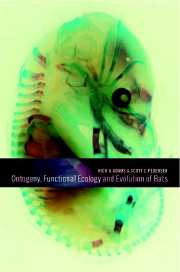Book contents
- Frontmatter
- Contents
- List of contributors
- 1 Integrating ontogeny into ecological and evolutionary investigations
- 2 Bat phylogeny: an evolutionary context for comparative studies
- 3 Early embryology, fetal membranes, and placentation
- 4 Brain ontogeny and ecomorphology in bats
- 5 Evolutionary plasticity and ontogeny of the bat cochlea
- 6 Skull growth and the acoustical axis of the head in bats
- 7 Ontogeny of the chiropteran basicranium, with reference to the Indian false vampire bat, Megaderma lyra
- 8 A theoretical consideration of dental morphology, ontogeny, and evolution in bats
- 9 Wing ontogeny, shifting niche dimensions, and adaptive landscapes
- 10 Ontogeny and evolution of the hindlimb and calcar: assessing phylogenetic trends
- 11 A comparative perspective on the ontogeny of flight muscles in bats
- 12 The ontogeny of behavior in bats: a functional perspective
- Index
5 - Evolutionary plasticity and ontogeny of the bat cochlea
Published online by Cambridge University Press: 17 August 2009
- Frontmatter
- Contents
- List of contributors
- 1 Integrating ontogeny into ecological and evolutionary investigations
- 2 Bat phylogeny: an evolutionary context for comparative studies
- 3 Early embryology, fetal membranes, and placentation
- 4 Brain ontogeny and ecomorphology in bats
- 5 Evolutionary plasticity and ontogeny of the bat cochlea
- 6 Skull growth and the acoustical axis of the head in bats
- 7 Ontogeny of the chiropteran basicranium, with reference to the Indian false vampire bat, Megaderma lyra
- 8 A theoretical consideration of dental morphology, ontogeny, and evolution in bats
- 9 Wing ontogeny, shifting niche dimensions, and adaptive landscapes
- 10 Ontogeny and evolution of the hindlimb and calcar: assessing phylogenetic trends
- 11 A comparative perspective on the ontogeny of flight muscles in bats
- 12 The ontogeny of behavior in bats: a functional perspective
- Index
Summary
INTRODUCTION
One of the central questions in zoology concerns the adaptations of sensory filtering mechanisms to species-specific environments. Echolocating bats represent ideal models in auditory neurobiology to understand the underlying principles from both phylogenetic and ontogenetic points of view. They have adapted basic mammalian features of sound transmission by external and middle ears, and of frequency analysis by the inner ear to the working range of their biosonar, which in certain species operates more than three octaves above the high frequency limit of hearing in humans. Furthermore, for matched filtering of the dominant components of their echolocation signals, certain species have evolved the most sharply tuned auditory receptor systems of the animal kingdom.
Following a brief introduction into sonar systems, the first part of this chapter describes comparative anatomical studies of the cochlea in bats. Special emphasis is devoted to an analysis of the structural variations on the common mammalian cochlear Bauplan as adaptations to ecological constraints and specialized acoustic performance. Diversity of cochlear mechanisms and the adaptive value of specialized features in cochlear morphology will be judged by a comparative analysis of 1) non-related bats who evolved Doppler-sensitive sonar systems via convergent evolution (Rhinolophus rouxi – Pteronotus parnellii), and 2) related bats that employ different types of sonar (P. parnellii – Pteronotus quadridens). The second part of the chapter addresses the question of how Doppler-sensitive sonar and specialized frequency analysis by the cochlea develops during ontogeny in horseshoe bats.
- Type
- Chapter
- Information
- Ontogeny, Functional Ecology, and Evolution of Bats , pp. 137 - 173Publisher: Cambridge University PressPrint publication year: 2000
- 10
- Cited by

